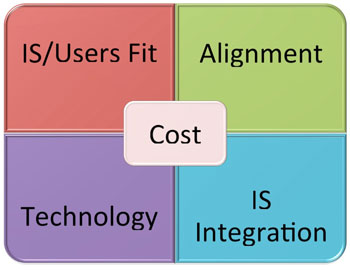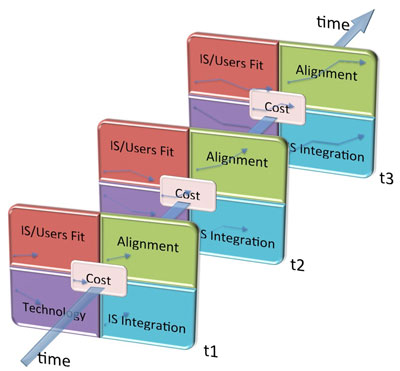This research proposes a framework (named EVOLIS) to study information systems (IS) evolution. The benefits of the EVOLIS framework are twofold. First, it gives managers a tool for assessing the impact of a change from either the user or the business/IS perspective. This can be used to design a strategy for IS evolution. Second, the repeated use of the EVOLIS framework reveals specific evolution patterns.
The rapid change occurring in business environments in response to evolving markets leads to a considerable amount of change in business processes. In order to cope with changes and new market opportunities, the information systems (IS) that support business processes need to be able to evolve.
The term evolution, in relation to software systems, has various interpretations depending on the role of stakeholder. When we refer to IS evolution we mean a process of discrete progressive change over time in architecture, workflows, features or functionalities of IS. For instance, an ERP system typically evolves by regularly adding new transactions, processes and views on business processes during its life cycle. The different stages of maturity successively provided by an e-banking application to customers is another example of IS evolution over time.
The goal of this research is to create a framework to evaluate the effects of IS evolution. In other words it must be able to characterize the impact of changes according to predefined criteria in order to help managers to refine their IS strategy.
The framework design should cover the following specifications:
- it should be easy for managers to understand and use
- it should address users’ perceptions of the system and their efficiency using the system
- it should take into consideration objective factors such as the maturity level of technology used, the alignment of the solution with the business and its level of integration.
The EVOLIS framework exists in the form of a canvas consisting of 4 blocks: IS/Users Fit, Technology, IS Integration and Alignment with the business.
The IS Fit with Users is measured using both subjective and objective approaches. The users’ satisfaction with the IS is measured using the well known perceived usefulness and perceived ease of use (TAM). These two variables determine whether users accept or reject an information technology. Perceived usefulness is defined as the degree to which a user believes that using the modified system would enhance job performance. Perceived ease of use is described as the degree of ease with which a person uses the modified system. Consequently, these two variables enable us to measure the perceived benefits or losses of a change. On the other side, the objective performance of users is calculated using measures such as efficiency and effectiveness to perform tasks.

Figure 1: The 4 building blocks of the EVOLIS framework in parallel with the cost of IS
The Technology, IS integration and Business/IS Alignment blocks provide information on how well the IS supports the business. The Technology block represents the degree of innovation, anticipation, flexibility, and scalability of the IS. The IS integration block evaluates the level of integration of the IS. It measures the delta between the past IS and the changed IS. There are different types of IS integration evolution, namely an evolution of integration among components of the system, among business functionalities, or an integration with systems outside of the company, etc. The Business/IS Alignment block describes the fit between business processes and IS processes. It also reflects on the scope of the IS, whether it is extended by the evolution and whether the evolution addresses core business functionalities or support functionalities.
These 4 blocks must be evaluated in parallel with the cost function of the IS. This provides an evaluation as to whether the ROI (return on investment) is satisfactory or not.
The use of the EVOLIS framework after each evolutio n of the system provides a temporal view of system evolution. It acts as an indicator to determine in which direction the system should evolve. The use of EVOLIS also helps managers to design the strategy of IS evolution. Moreover, a temporal view clearly identifies specific evolution patterns of the IS.

Figure 2: Multiple uses of the EVOLIS framework with the temporal evolution of each building block
This research is conducted using a design science approach in IS. The design and the development of the EVOLIS framework is an iterative process based on case studies and practitioner interviews to refine and demonstrate the use of this framework. The evaluation of EVOLIS will be qualitative, principally based on practitioners’ feedback and satisfaction surveys. We will determine whether IS managers are willing to adopt the EVOLIS framework to evaluate the evolution of their IS and to use it as part of their IS strategy.
This research originated from a PhD project in the Information System Institute of the Faculty of Business and Economics at the University of Lausanne. The work, which commenced in 2010, is ongoing.
Please contact:
Alexandre Métrailler
University of Lausanne, Switzerland
Tel: +41 22 692 35 86
E-mail:










